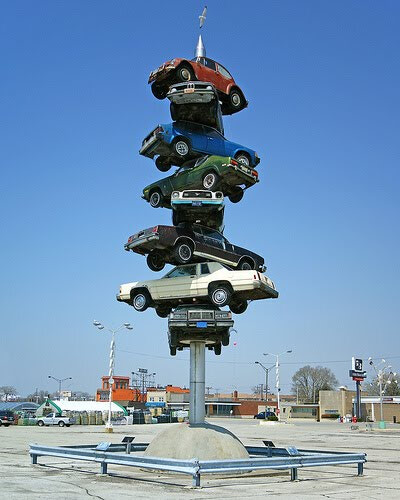Parking Lots Endangered Landscape Feature
A recent article by Paul Kaihla in BUSINESS2.0 Magazine brought me to think about the parking lot as a prolific, yet endangered landscape feature of the post war era.
The article, entitled The Next Real Estate Boom (November 1, 2005) spoke of a coming wave of expansion, growth and redevelopment of American cities, of a scale not seen since the decade immediately following the Second World War, to accommodate 70 million more people. It congealed several concepts that aren’t terribly out of the realm of imagination – “megapolitans” infilling the areas between cities, such as one urban unit consisting of Seattle and Portland; in a way, not unlike how Baltimore / Washington are being reported as a single census unit today. It predicted that existing neighbourhoods may be infilled, perhaps densified, to allow for energy conservation. In my estimation, this type of growth would require a similar movement to preserve agricultural lands, in order to feed the additional hordes of people. A quirky snippet from the article is what caught my eye, concerning the redevelopment potential of surface parking lots in American cities.
They paved paradise / And put up a parking lot
With a pink hotel, a boutique / And a swinging hot spot
Don’t it always seem to go
That you don’t know what you’ve got ’till it’s gone
They paved paradise / And put a parking lot
Joni Mitchell, big yellow taxi
Parking lots have been somewhat of a fascination, if not an icon of post war growth. More people became mobile, we came to expect large, convenient surface areas where we could park our flamboyantly styled yacht of sheet metal, as if to put of symbol of status on display for all to see while we engaged in some activity of commerce within close walking distance. Like them or not, parking lots were an important component to the generation of gross national product. While many times they were our bane – like when Life Magazine declared a hillside completely paved in asphalt as being one of the worst urban eyesores of the year; they achieved an undercurrent of recognition and appreciation in other, equally artistic circles.
“Thirty Four Los Angeles Parking Lots” by Beat Era guru Edward Ruscha elevated expanses of empty pavement to high art – a quite random pattern of oil spots that were actually well organized. One winner of the 1978 “McDonald’s of the Future” design competition if the American Institute of Architecture Students realized their design was to place a building seen behind a backdrop of cars in a parking lot, so that parked cars were arranged with the same care and fashion as one would expect to see soup cans placed in a supermarket display. Even our own Cermak Shopping Plaza in Berwyn, Illinois turns a parking lot into a glamorous art gallery.
Quite properly, some may begin to wonder just what has happened to our sense of art, if we see surface parking lots as being our highpoint of artistic expression.
True, the sort of vehicles we park these days all tend to look like everyone else’s, even automotive interiors are rarely offered in vibrant colours like they once were. It’s imaginable that the want to display our vehicle has gone by the wayside. Perhaps lengthening commutes have made driving more drudgery than pleasure, we’re not as attached to our automobiles as we once were. And perhaps time has come to rethink the parking lot. The Chicago area has several examples of what can be done if a portion of the parking lot is developed into a parking garage that can hold at least as many vehicles as once parked on the surface, and the remainder of the site redeveloped as something else. The parking lot’s sense of scale is what’s most intriguing; by tract standards, they are relatively small, lending themselves to development by smaller, private groups, much the same entrepreneurial spirit that saw to their initial development. What’s more, parking lots are usually well located, their location is handy to urban amenities.
Joni Mitchell’s lyrics bring to mind a quote Prince Charles once made about London tabloid newspaper; how they took perfectly wonderful wooded forests, and cut down all the trees to process into pulp newsprint that in turn became Fleet Street tabloids that printed stories of dubious gossip. In our case, the original landscape that was turned into surface parking lots may not be salvageable. However, the integration of parking lots into worthwhile neighbourhoods is akin to turning the proverbial sow’s ear into a silk purse
Written by Darrel G. Babuk, Architect AAA, NCARB, MRAIC

